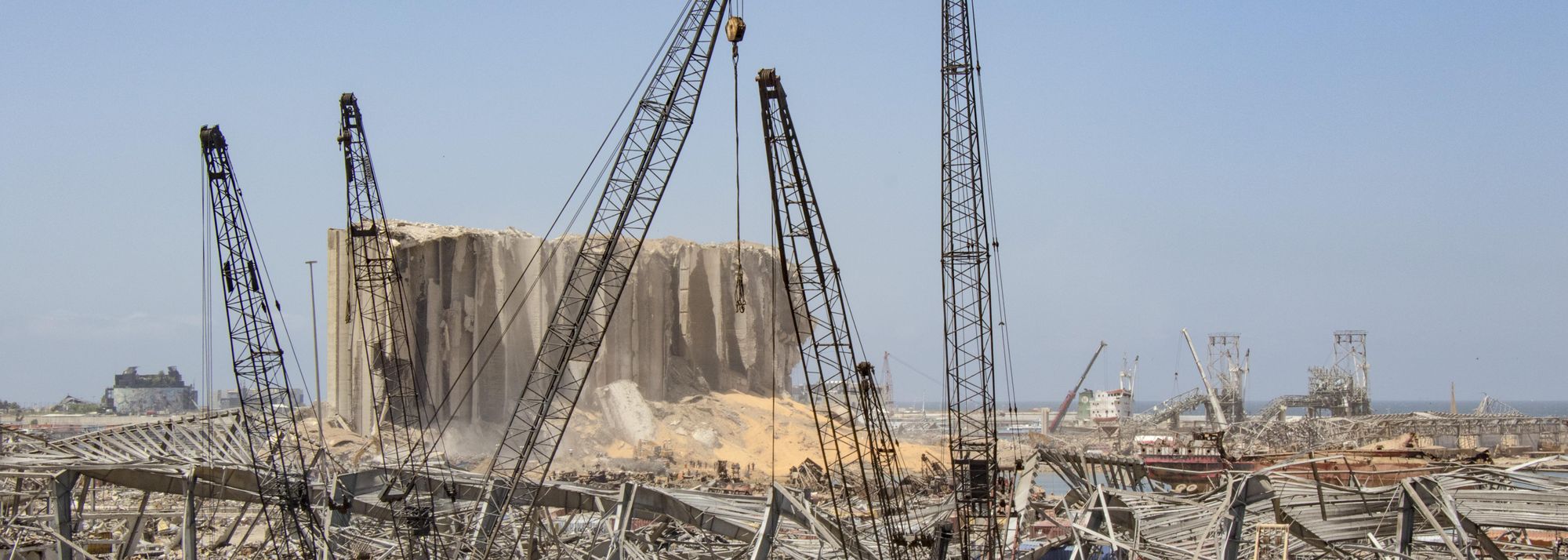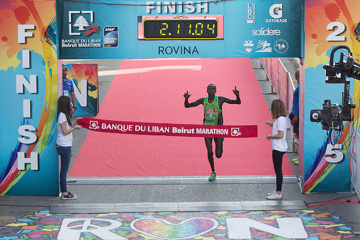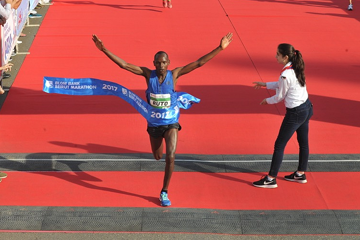The Beirut port after the deadly August 2020 explosion (© Christel Saneh)
On 4 August, a horrendous explosion at the port of Beirut rocked the Lebanese capital, killing more than 200 people, wounding more than 6000, and leaving an estimated 300,000 homeless. The blast, caused by a vast store of ammonium nitrate, levelled the immediate port area, causing an estimated $10-15 billion in damage. More than 80,000 families have been directly impacted by the blast, considered to be one of the most powerful non-nuclear explosions in history.
To assist in the ongoing relief and re-building efforts, the Beirut Marathon Association is organising Embrace Beirut, a global virtual non-competitive 5km charity race in support of the Lebanese Red Cross which has been providing much of the relief to victims of the blast. The race kicked off today and continues through 8 October. You can register via BMA's website or Facebook event page.
Christel Saneh, an illustrator, photographer and World Athletics correspondent who lives near Beirut, provides this personal account of the blast and its aftermath. As a competitive long jumper and runner herself, Saneh also reached out to members of the city’s running community - athletes, coaches and medical professionals - to report on how local athletes have coped with the trauma left in the explosion's wake.
~
Beirut – 4 August, 6:09pm
Sirens blare, shrapnel whistles through destroyed buildings, shattered glass litters the streets, tall buildings are reduced to dust. This is a war zone, you might think. And yes, maybe it was. Beirut went through 15 years of war in a matter of 15 seconds.
Beirut - 4 August, 6:08pm
A resonating sound, a blinding light, intense pressure, and boom! An explosion goes off at the heart of the city, in the Beirut Port. There’s a large mushroom in the sky. Below it buildings on the ground are wiped out in a matter of seconds. Large parts of the city are left in rubble. You hear people crying, lost and confused, not knowing where to go or what to do. They don’t know where to hide or where to go to fix their wounded bodies in their wounded city. A cloud of dust reigns over the capital in an apocalyptic scene never witnessed before.
And just like that, Beirut was gone.
This is the story of thousands of Lebanese people who survived the explosion. Around 300,000 people lost their homes that day including 80,000 children, and hundreds of thousands are living in damaged houses.
The investigation is ongoing, but initial evidence showed that the blast was caused by 2750 tonnes of ammonium nitrate poorly stored in the port’s warehouse 12, in the heart of the capital. First a fire emerged, then a small explosion, and seconds later, what looked like a nuclear explosion followed; the third biggest in history after Hiroshima and Nagasaki.
Over the past months, there has been a growing public anger in Lebanon. The country was already suffering the worst economic collapse in its history, inflation rate at 80%, a huge currency depreciation and the Covid-19 pandemic, all amidst great political instability that has been going on for at least three decades. Four days after the blast, protesters took their rage and frustration to the streets once again to demand justice for the victims.
Coping with trauma
After 6:08pm on 4 August, we all experienced a traumatic event in one way or another - if we hadn’t already been traumatised after surviving wars, assassinations, explosions or bombing. Some lost their loved ones and are still grieving, others lost their homes and have no place to go, others lost a part of themselves seeing their capital reduced to rubble.
Trauma is an emotional response to events caused by human behaviour such as war, family loss or separation, injustice or industrial accidents, as well as any disturbing experience that a person finds highly stressful and that triggers feelings of fear, helplessness and confusion. The Beirut blast is the perfect example of it, and it embodies most of the above.
What Lebanese citizens are experiencing now can be described as collective trauma, a traumatic event witnessed by an entire society, but one that each individual will react to differently.
Six days after the blast, I realised that I hadn’t been training since the explosion. My reason was obvious; I would rather be helping instead of training, a reaction which was adopted by thousands of people in Lebanon who voluntarily rushed to Beirut to help in different ways, all showing genuine support to their fellow citizens.
This is when I started to wonder about runners returning to training after the explosion. Many athletes reacted the same way I did, while others resumed training two days after the blast. I reached out to different Lebanese athletes to try and figure out what their reaction to the event was, before talking about it with specialists.
Beirut is a home of runners, known for the Beirut International Marathon, a World Athletics label road race, which was founded to unite the country regardless of its diversity. The marathon organised a women’s 10km race at the Beirut port last year, now little more than a fond memory after this tragedy.
‘A huge moral wound’
On the day of the blast, a group of runners was heading towards the port on a traditional course that all runners take in the capital, stretching from the landmark “Raouche”, “the Rock”, towards the Beirut waterfront next to the port.
Alia Haidar was one of the runners who was running along the waterfront, less than a kilometre away from the explosion. She stopped to look like everyone else; she didn’t know then that she was witnessing one of the biggest explosions in history. Fortunately, she wasn’t hurt and continued running towards her car.
“The explosion left in me a huge moral wound, but at the same time, it strengthened my attachment to the city of Beirut,” Haidar said. “This is where I had my first run, this is where I train every day, and this is where I plan on staying, especially after what happened. I most certainly will not leave this place.”
The next day Haidar couldn’t run because of what she had experienced, but the day after, she ran again along her usual route. She was feeling down and physically tired, but she kept going. Day after day, she began feeling better.
On a normal Sunday in Beirut, you can see runners from all over the country running along the waterfront. On the first Sunday after the blast, it was a ghost town. On that day, Haidar ran 50 kilometres in preparation for the IAU 6-hour Global Solidarity run. She insisted on doing it at the place where she witnessed the explosion.
On the road parallel to the port, about 700 metres away from the explosion, Ahmad Ghalia, who specialises in the 3000m steeplechase, was running with two of his teammates when the blast occurred. He first thought it was an airstrike and his immediate reaction was to hit the ground and make sure his teammates were safe. Right after the blast, he helped clean up the shattered houses of his coach and teammates, before resuming running a few days later.
“You feel relieved when you run,” Ghalia said. “Life isn’t easy, in fact, it is really hard, but you can’t fall and not get up. It will drag you down.”
I reached out to Roger Bejjani, the president and distance coach of the Inter-Lebanon club. Most of his athletes were running in Beirut that day, including Ahmad.
“I have lived through 15 years of trauma in Lebanon – one war at a time, one loss at a time, one heartbreak at a time,” Bejjani said. “Lebanon has forced me to become a specialist in coping with major trauma.”
He insisted on training the team on the waterfront, not giving in to despair or depression. He believes in keeping the team training as usual, thus allowing his athletes to stick to their routine.
On the other hand, Bouchra Doueihi, a marathon runner who is on the rebound from an ACL injury, was in a mall at the time of the blast. She miraculously survived, and ran to her house to find people in the streets in pools of blood and her home reduced to pieces. She then left for Ehden, a mountain town about 110 kilometres from the capital.
“I tried running (the day after the blast) because I couldn’t sleep at all,” Doueihi said. “My heart rate was 180 for an easy pace, it felt like my legs were so heavy.
“The next day, it was the same thing. But when I move, I stop seeing the horrible pictures in my head. Every time I remember the incident, my joints hurt and I feel heavy. When I run, I feel in control and I forget what happened, it is kind of an escape.”
‘Just like my city, I was collapsing’
Lea Bou Khater is a Lebanese triathlete who recently returned to Lebanon after living in London for three years. She was outside of Beirut when the explosion occurred but rushed to the capital to check the damage done to her home.
“I’ve been in love with Beirut,” Khater said. “It took me some time to find the place I wanted to live in, my training and my teammates. Within this violent unstable city, I built myself a bubble of stability that made me feel safe, and proud to be a part of. I had a special thing for the harbour, with its big cranes, big ships and big containers. I felt like this was an assemblage of a real city, and it reinforced my feelings of safety on my morning runs.
“When the explosion happened, the image of Beirut which I had built in my head, was destroyed. I didn’t want to see the city demolished; it was a humiliation to every citizen. I was scared, insecure and anxious to a point that I decided to stop sports completely.
“But the minute I told my sport psychologist about my decision, I realised that it was tangible evidence that just like my city, I was collapsing. I knew deep down that exercise would help me, so I decided, a week after the explosion, to try and run an easy 30 minutes to see how it goes, and I felt better that day.”
Can running help alleviate trauma?
I reached out to Wissam Kheir, a clinical psychologist and himself a runner, Nicole Hawi, a specialist in Child and Adolescent mental health, and sports psychologists Karim Ramadan and Nathalie Jbeily, respectively a mountain runner and former basketball player, to see if running has been known to alleviate symptoms of trauma.
It is important to understand that people may experience different symptoms such as anxiety, flashbacks, and persistent memories of events as well as avoidance behaviours. They might feel a range of emotions - denial, anger, sadness, uselessness, guilt, numbness, anxiety, a difficulty concentrating.
Kheir said that these are normal reactions to traumatic events. Most people, he said, including himself, experienced insomnia, headaches, fatigue, loss of appetite, body aches or loss of motivation. It was completely normal for athletes not to train the day after such an event.
But Kheir added that running was a part of an athlete’s routine and that it was important to stick to it. It would even help in the healing process.
“Those who decided to run on the waterfront exposed themselves in vivo to break the avoidance behaviour,” Kheir said. “Exposure is one of the techniques we use to get used to the traumatic event. But it is also normal for others to take their time to recover in their own manner.”
Trauma triggers physical symptoms such as a racing heartbeat, fatigue, sweating and hypervigilance, reactions that are commonly experienced by athletes when practising sports activities. The fact that athletes are used to the same physical reactions, Kheir said, suggests that athletes can cope better with a stressful event.
Physical exercise has proven to reduce anxiety and depression, and can improve moods and feelings of well-being. It can also be a diversion from unpleasant stimuli and pain, Ramadan notes.
“Exercise can take a form of an escape which can be considered as a dissociation from reality, thus it falls under the denial phase and drifts us away from the acceptance phase,” Ramadan said. “Exercise is very important in mood regulation; however, it shouldn't be sought as a first-hand solution for mood modification.”
Jbeily agrees, adding that any extreme behaviour can represent a defence mechanism of some kind. But when running is used as such, “it is not unhealthy, as most people need this escape. It is crucial, however, for the person not to overwork himself, so he doesn’t distance himself from his feelings. The acceptance of the disaster and dealing with its consequences will pop up at later stages.”
Sport in general and running in particular, has taught us to be resilient, to never surrender, and to fight for our goals. This also applies to life. After witnessing the events surrounding the explosion the message that I can share to all athletes around the world is: “Be grateful for being able to do what you love. Do not wait for tragedies to find joy in the simple things, because you never know when life can strip away what you love most.”
Christel Saneh for World Athletics








